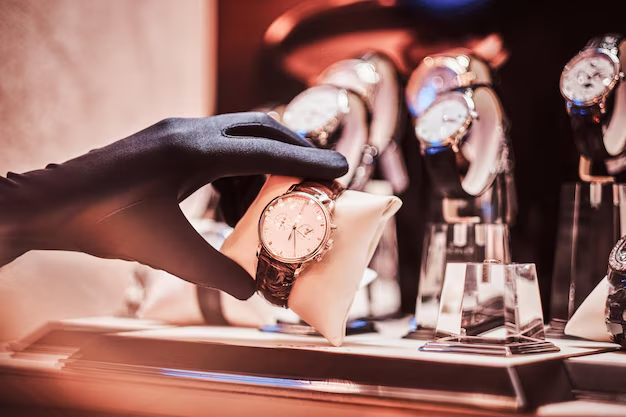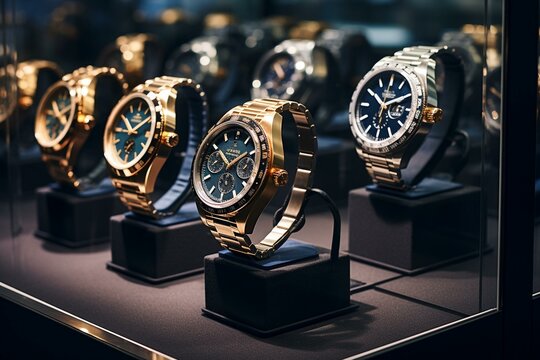Luxury watches transcend mere timekeeping; they are intricate mechanisms, miniature works of art, and coveted status symbols. Stepping into the world of luxury watches is to embark on a journey of unparalleled craftsmanship, innovation, and rich history.
This blog post will delve into the captivating realm of luxury watches, exploring various aspects that make them so desirable:
A Legacy of Precision: A Historical Timeline
We’ll embark on a historical journey, tracing the evolution of watches from their early mechanical origins to the high-tech marvels of today. We’ll explore the contributions of pioneering watchmakers and the innovations that shaped the industry.
The Art of Watchmaking: Unveiling the Inner Workings
Luxury watches are marvels of engineering, housing hundreds of tiny components working in perfect harmony. We’ll delve into the intricate mechanisms that power these timepieces, exploring the complexities of movements, complications, and escapements.
A Symphony of Materials: Exploring Exquisite Watch Construction
From the gleaming stainless steel to the exotic allure of platinum, luxury watches are crafted from a variety of exceptional materials. We’ll explore the properties of these materials, their impact on a watch’s durability and aesthetics, and the challenges of working with them.
The Allure of Design: From Classic Elegance to Daring Innovation
Luxury watch design encompasses a spectrum of styles, from the timeless elegance of the dress watch to the bold functionality of the dive watch. We’ll explore iconic watch designs that have stood the test of time, alongside the innovative concepts pushing the boundaries of watchmaking aesthetics.

Beyond Aesthetics: The Value Proposition of Luxury Watches
While the beauty and craftsmanship of luxury watches are undeniable, their value proposition extends beyond aesthetics. Here are some additional factors to consider:
Investment Potential:
Certain luxury watches, particularly those from well-established brands with limited production runs, can hold their value or even appreciate over time.
Family Heirlooms:
Luxury watches can be passed down through generations, becoming cherished family heirlooms imbued with sentimental value.
A Celebration of Achievement:
A luxury watch can be a significant purchase, marking a personal milestone or achievement.
The Satisfaction of Ownership:
Owning and wearing a well-made luxury watch can bring a deep sense of satisfaction and appreciation for quality craftsmanship.
Choosing Your Perfect Timepiece: Factors to Consider
Before diving into specific recommendations, let’s explore some key factors to consider when choosing a luxury watch:
Budget:
Luxury watches range in price from several thousand dollars to hundreds of thousands or even millions. Determine a realistic budget to guide your search.
Lifestyle:
Consider your daily activities and choose a watch that complements your lifestyle. For example, a dive watch might be ideal for someone who enjoys water sports, while a dress watch might be better suited for formal occasions.
Personal Style:
Luxury watches come in a variety of styles. Choose a watch that aligns with your personal taste and complements your wardrobe.
Brand and Reputation:
Luxury watchmakers have cultivated rich heritages and reputations for quality. Research different brands to understand their strengths and specialties.
Disclaimer:
While some watch brands and models are mentioned throughout this blog post, it’s important to remember that this is not a ranked list. The “best” luxury watch is subjective and depends entirely on your individual needs and preferences. Consider this information as a starting point for your own exploration of the fascinating world of luxury watches.
Further Exploration:
Throughout this blog post, we’ll delve into various aspects of luxury watches, providing a foundation for your research. We’ll explore renowned watchmakers, iconic watch designs, and the exciting world of watch collecting.
This comprehensive guide will equip you with the knowledge and appreciation to embark on your own journey into the captivating world of luxury watches. So, join us as we unveil the intricate mechanisms, rich history, and timeless elegance of these coveted timepieces.

A Legacy of Precision: A Historical Timeline
Our exploration begins with a journey through time, tracing the evolution of watches from their early mechanical origins to the high-tech marvels of today. Here are some key milestones:
- 16th Century: Spring-driven watches, the first portable timekeeping devices, emerge in Europe. These early watches were highly inaccurate and required frequent winding.
- 17th Century: The invention of the balance spring by Christiaan Huygens in 1675 revolutionized watchmaking, leading to significantly improved accuracy.
- 18th Century: Pocket watches become popular among the wealthy and elite. Watchmakers focus on miniaturization and decorative elements, creating exquisite timepieces.
- 19th Century: The development of the American Waltham Watch Company’s interchangeable parts system in 1854 ushered in an era of mass production, making watches more affordable.
- 20th Century: The invention of the wristwatch during World War I for soldiers in the trenches marked a major shift in watch use. Technological advancements like the quartz movement in the 1960s led to even greater accuracy and affordability.
- 21st Century: Luxury watchmakers continue to push boundaries with innovative materials, complex complications, and cutting-edge technology. Today, luxury watches represent a fusion of tradition, precision engineering, and artistic expression.
The Art of Watchmaking: Unveiling the Inner Workings
Luxury watches are marvels of engineering, housing hundreds of tiny components working in perfect harmony. Let’s delve into the intricate mechanisms that power these timepieces:
- Movements: The movement is the heart of a watch, responsible for keeping time. There are two main types of movements: mechanical and quartz.
- Mechanical Movements: These traditional movements are powered by a mainspring that unwinds and releases energy, driving the gear train and ultimately the hands of the watch. Mechanical movements can be further categorized as automatic (self-winding) or manual (wound by hand).
- Quartz Movements: These more modern movements use a battery and a quartz crystal to keep time electronically. They are generally more accurate and require less maintenance than mechanical movements.
- Complications: Complications are additional features beyond basic timekeeping, such as date displays, chronographs (stopwatches), moon phases, and even minute repeaters that chime the time on demand. The inclusion of complications adds to the complexity and value of a luxury watch.
- Escapements: The escapement is a critical component of a watch movement that regulates the release of energy from the mainspring, ensuring the watch keeps accurate time. There are various types of escapements, each with its own strengths and weaknesses.
A Symphony of Materials: Exploring Exquisite Watch Construction
From the gleaming stainless steel to the exotic allure of platinum, luxury watches are crafted from a variety of exceptional materials. Here’s a closer look at some popular choices:
- Stainless Steel: A versatile and durable material, stainless steel is widely used in luxury watches due to its resistance to corrosion and scratches.
- High-Tech Ceramics: These advanced materials offer exceptional scratch resistance and lightweight properties, making them ideal for sports watches.
- Sapphire Crystal: This incredibly hard and scratch-resistant material is the preferred choice for watch crystals, protecting the delicate movement from damage.
- Precious Metals: Luxury watchmakers also use precious metals like gold, platinum, and rose gold for their beauty, exclusivity, and resistance to corrosion.
- Exotic Materials: Some high-end watchmakers utilize exotic materials like carbon fiber, titanium, and even meteorite in their creations, pushing the boundaries of watch construction.
The choice of material impacts a watch’s aesthetics, durability, weight, and overall value. Understanding the properties of different materials can help you make informed decisions when considering a luxury watch purchase.
